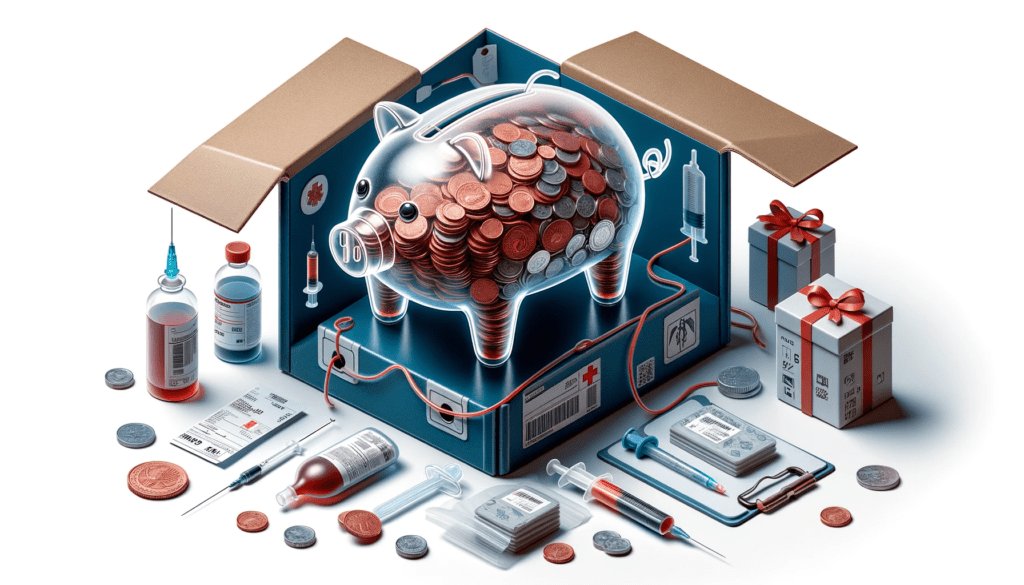
Cost Breakdown: Cord Blood Kit Shipping & Storage – Imagine the first golden rays of dawn caressing a new life, and in that moment of joy, you’re safeguarding their future with a decision to store their cord blood.
As someone committed to serving others, you understand the importance of investing in health and peace of mind.
You’re considering the costs associated with shipping and storing a cord blood kit, which include the initial price for the collection kit, the processing fee for the lab work, and the annual charges to keep the stem cells securely stored in cryogenic conditions.
It’s a thoughtful journey you’re embarking on, where every detail from transport to long-term storage demands careful financial planning.
Here’s a concise guide to help you navigate the expenses, so you can focus on what truly matters—providing for and protecting those you serve.
Key Takeaways
- Cord blood banking involves both initial investment and annual storage costs.
- Collection kit pricing includes components for safe collection and transport of stem cells.
- Retrieval process fees are separate from storage fees and cover removing the sample from storage and preparing it for transportation.
- Transport service charges and temperature control costs are additional expenses incurred during shipping and delivery of cord blood samples.
Understanding Cord Blood Banking

Cord blood banking is your proactive step in preserving your newborn’s stem cells for potential future medical use. By choosing to store these valuable cells, you’re potentially equipping healthcare providers with a powerful resource for combating certain life-threatening diseases.
When considering cord blood banking, you’re faced with the decision between public vs private banks. Public banks generally don’t charge for the storage of cord blood, as the donated cord blood becomes a public resource for patients in need and for research purposes. Private banks, on the other hand, offer exclusive access to your stored cord blood for a fee.
The costs of cord blood banking with private facilities typically include processing fees and annual storage fees. These fees ensure that your newborn’s cord blood is processed following stringent international standards, tested for viability and infection, and securely stored in liquid nitrogen. While public banks absorb these costs through funding and donations, opting for a private bank means you’ll be responsible for these ongoing storage fees.
Understanding these expenses is crucial for making an informed decision that aligns with your family’s values and financial planning.
Now, let’s delve into the specifics of collection kit pricing overview, which is another integral component of the cord blood banking process.
Collection Kit Pricing Overview

You’ll find that the initial investment in a cord blood collection kit is a key part of the overall banking process, encompassing necessary tools and services for safe and efficient stem cell preservation. When you opt for cord blood banking, whether it’s through a public cord blood bank or a private one, the collection kit is your first step towards securing a potentially life-saving resource for your family or others.
The price of the collection kit typically encompasses:
- The Breadth of Hope: All the components required for the safe collection and transport of your baby’s precious stem cells.
- The Essence of Preparedness: Vials for the mother’s blood tests to ensure everything is ready for the moment your little one arrives.
- The Pledge of Quality: Access to specialized courier services that swiftly and securely deliver the collected samples to the lab for processing and storage.
Retrieval Process Fees

Once your initial investment in the collection kit and storage is set, you’ll also need to consider the retrieval process fees for when the time comes to access your banked stem cells. These fees are separate from your annual storage costs and can vary significantly depending on whether the stem cells are stored in a private facility or a public bank.
In a private banking scenario, retrieval process fees are often outlined in your service agreement. These fees cover the costs associated with removing your sample from storage, preparing it for transportation, and ensuring it meets all necessary safety and viability standards for clinical use. It’s important to understand these costs upfront, as they can be substantial and are typically not included in the annual storage fee.
If your cells are stored in a public bank, the retrieval process may have different financial implications. While public banks often provide stem cells at no cost to the recipient, the associated administrative and handling fees still apply. Consequently, you should thoroughly investigate these costs as part of your decision-making process.
As you navigate these financial aspects, don’t overlook the transport service charges, which represent another crucial component of the total cost. Let’s delve into what you can expect in terms of transport service charges in the next section.
Transport Service Charges

When considering transport service charges, you must account for the variability in shipping methods, which can significantly impact cost.
Temperature control during transit is essential and incurs additional expenses to ensure the viability of the cord blood samples.
If you require expedited delivery, be prepared to pay a premium for this time-sensitive service.
Shipping Method Variability
Why are the costs for shipping your cord blood kit so variable? Cord blood banks store these precious cells with the utmost care, and the method of transport is critical. When you store cord blood, consider the following factors affecting shipping method variability:
- Distance: The further the cord blood collected needs to travel, the higher the transport cost.
- Speed: Expedited shipping ensures prompt storage but at a premium rate.
- Service Quality: Reliable couriers with track records of careful handling may charge more.
Each of these elements is crucial for the safe delivery of your baby’s cord blood to the storage facility. Grasping these factors can help manage expectations and budget accordingly.
Next, we’ll explore the implications of temperature control costs on the overall financial investment.
Temperature Control Costs
In managing the costs associated with cord blood banking, you’ll find that temperature control during transport plays a significant role in the overall expense. Private banks ensure that cord blood cells are kept at optimal conditions, which is essential but adds to the temperature control costs. The table below outlines key aspects of these charges:
| Service Feature | Importance | Impact on Cost |
|---|---|---|
| Validated Protocols | Ensures cell viability | Increases cost |
| Specialized Containers | Maintains required temperatures | Adds to expense |
| Monitoring Systems | Tracks temperature during transport | Essential charge |
These elements are vital for the safe transport and storage of cord blood cells. Now, let’s transition to discuss the expedited delivery premium, another crucial factor in the cost equation.
Expedited Delivery Premium
You’ll often find that the expedited delivery premium significantly impacts the total cost of shipping your cord blood kit. When you opt for a public bank to handle your cord blood donation, consider the following:
- Time Sensitivity: The viability of blood stored hinges on rapid transport, and the expedited delivery premium ensures the sample arrives swiftly.
- Secure Transit: This fee guarantees that your precious donation is handled with utmost care and urgency.
- Reliability: Paying for expedited service means peace of mind, knowing that your contribution to potentially life-saving treatments is prioritized.
These elements are essential to maintain the integrity of cord blood cells, and while the expedited delivery premium adds to the cost, it’s a critical investment in the future health of others.
Shipping Insurance Considerations

When selecting a shipping insurance policy for your cord blood kit, it’s critical to ensure it covers the kit’s full value, from collection through transport to storage. This means that the insurance shouldn’t only account for the cost of the kit itself but also the invaluable potential treatments it represents. In the event of damage or loss, you want to be confident that your investment is protected comprehensively.
Delve into the details of the shipping insurance policy. Confirm that it offers airtight coverage for the entire transportation process—this includes the journey from the hospital or collection site to the storage facility. Given the unique nature of cord blood as a biological sample, it’s essential to verify that the policy doesn’t impose any exclusions that could affect your kit.
Rush Delivery Options

Considering the importance of timely delivery for your cord blood kit, exploring rush delivery options can provide the assurance that your sample reaches the storage facility as quickly as possible. When your due date approaches, it’s crucial to have a plan for swift and secure transport of this precious cargo to safeguard its viability for future use.
Analyzing the rush delivery options for your cord blood kit shipping isn’t just about logistics—it’s about peace of mind and ensuring the best care for your family:
- Guaranteed Timeliness: Rush delivery promises that your cord blood kit arrives at the storage facility within a specified time frame, minimizing the risk of sample degradation.
- Priority Handling: Your kit receives preferential treatment, reducing the chances of delays or mishandling during transit.
- Direct Support: Access to dedicated customer service ensures any concerns are promptly addressed, providing you with continuous support and information.
Each of these elements plays a vital role in the preservation of the cord blood, which could be critical for addressing health issues in the future.
International Transport Costs

As you explore the logistics of cord blood banking, it’s essential to factor in the international transport costs that come with shipping your kit to and from the CryoSave laboratory. The moment your baby’s umbilical cord and placenta are collected, the clock starts ticking. Cord blood kit shipping is a time-sensitive affair, and banks must ensure that these precious cells are transported quickly and securely across international borders.
These international transport costs are influenced by various factors, including the distance between your location and the CryoSave lab, the urgency of the shipment, and the specific import/export regulations of your country. It’s important to understand that these costs aren’t merely for postage; they encompass custom clearance fees, carrier handling charges, and ensuring that the biological material is kept at the necessary temperature throughout its journey.
When seeking a personalized quote from CryoSave, be sure to inquire about the full scope of the international shipping process. Transparency here will help you avoid any unexpected expenses and ensure that the transition from collection to storage is seamless.
As you consider these international transport costs, also prepare to navigate the handling and administration fees associated with cord blood banking—a critical component in the next phase of your decision-making process.
Handling and Administration Fees

You’ll also encounter handling and administration fees, which are critical to the secure processing and storage of your baby’s cord blood. These fees aren’t mere formalities; they’re essential for maintaining the integrity and potential of the invaluable stem cells collected immediately after the umbilical cord is cut. Here’s what they cover:
- Expert Coordination and Care: A specialist team meticulously manages the cord blood from the moment it’s collected, ensuring that your baby’s lifeline is handled with the utmost precision and care.
- State-of-the-Art Processing: Your donated cord blood is processed in a validated laboratory, adhering to AABB accreditation standards, to preserve every precious stem cell.
- Long-term Commitment: Administration fees also contribute to the ongoing responsibility of safeguarding the cord blood, guaranteeing its viability whenever it’s needed.
When considering cord blood kit shipping & storage, it’s crucial to recognize that handling and administration fees aren’t superfluous; they’re investments in your child’s health future. These fees support a system designed to serve families at a moment’s notice, providing peace of mind that the cord blood is ready and waiting, should it ever be necessary to tap into this regenerative resource.
Temperature-Controlled Logistics Expenses

Temperature-controlled logistics expenses are a significant part of the cost when preserving your baby’s cord blood. This intricate process begins with the shipping of the collection kit, which demands specialized courier services equipped to maintain the necessary temperature range. The cells from cord blood require meticulous handling to ensure viability, thus incurring additional costs.
Upon arrival at the laboratory, cord blood samples undergo processing following validated protocols that necessitate temperature-controlled environments, further adding to logistic expenses.
Moreover, the long-term storage of cord blood and cord tissue is conducted at an exacting -196°C, achievable only through the use of sophisticated cryogenic nitrogen freezing tanks. This level of cold storage is essential in preserving the integrity of the stem cells within the cord blood, ensuring they remain viable for future therapeutic use.
Quality testing forms another layer of expense, as the samples must be transported and processed under stringent temperature controls to accurately measure blood-forming stem cell counts and to detect any microbiological infections.
Lastly, the secure storage facility, where cord blood is kept, must sustain a constant temperature-controlled environment. This isn’t just a regulatory requirement but a pledge to safeguard these precious cells, which together comprise a substantial portion of the overall temperature-controlled logistics expenses.
Frequently Asked Questions
How Much Does a Cord Blood Collection Kit Cost?
It’s included in the initial signup cost for stem cell banking. For an exact figure, you should request a personalized quote from CryoSave.
How Do You Ship Cord Blood?
You’ll ship cord blood via specialized medical courier after collection. They ensure it remains at the correct temperature and is delivered promptly to the processing facility for safe and accurate handling.
How Much Does It Cost to Get a Cord Blood Registry?
Registering for a cord blood bank isn’t cheap, but you’ll find flexible payment options. The costs cover collection, processing, and secure long-term storage, ensuring your baby’s stem cells are safely preserved.
Why Is Cord Blood Banking so Expensive?
Cord blood banking’s high cost stems from specialized processing, quality testing, and long-term cryopreservation. Ensuring its reliability for future treatments requires substantial investment in technology and expertise.





